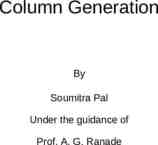Architecture in Colonial India British Colonial era lasted in India
16 Slides788.22 KB

Architecture in Colonial India British Colonial era lasted in India for over three centuries starting from 1615 to 1947. Colonization of India also had a great impact on architecture Colonization marked a new chapter in Indian architecture. Colonial architecture culminated into what is called the Indo-Saracenic architecture. The Indo-Saracenic architecture combined the features of Hindu, Islamic and western elements Colonial architecture exhibited itself through institutional, civic and utilitarian buildings such as post offices, railway stations, rest houses and government buildings

Anglo-Indian church builders to follow the model set by Gothic art in Italy/England Indo Saracenic Architecture: Indo-Saracen is Revival architecture also referred as Indo-Gothic, Neo-Mughal, Mughal-Gothic and Hindu-Gothic. It was a combination of the Gothic revival style with that of the Neo-Classical, Indo-Islamic and Indian architectural style that was initiated by the British architects.

St Paul's Cathedral, Kolkata St Paul's Cathedral, Kolkata, India. Architect: William Nairn Forbes (1796-1855) The first stone was laid in 1839, and the building was completed in 1847. This makes St Paul's the first Anglican cathedral of the Victorian age The building was constructed in a peculiar brick the dressings were of Chunar stone The whole edifice was covered inside and out with polished chunam“ The latter is a kind of stucco, and it gives the cathedral almost an ethereal aspect. St Paul's as the very first Anglican cathedral outside Britain, was inspired by James Gibbs's St Martin's-inthe-Fields by Trafalgar Square in London.

The cathedral was to lose its steeple later on, as a result of earthquakes, but the redesigned early twentieth-century tower is still "on the pattern of the Bell Harry Tower of Canterbury Cathedral" Interior "The roof is unusual. It is a shallow curve spanned by iron trusses adorned with Gothic tracery," explains Davies: "when built, it was one of the largest spans in existence"

Town Hall Town Hall is one of the most majestic structures among the other heritage buildings in the city of Mumbai. The Town hall was colloquially called as 'Tondal' during the 19th century. The Town Hall houses the 'Asiatic society of Bombay' (Mumbai) Mumbai's Town Hall is a colonial structure and was built in 1833.

Architecture The Town Hall was designed by Colonel Thomas Cowper who was one of the best engineers in Bombay (Mumbai). With a span of 200 feet and height of 100 feet, the structure was inspired by Greek and Roman styles of architecture. The entrance of the building is adorned with a Grecian portico and 8 impressive Doric styled pillars. There is a flight of 30 steps leading to the entrance of the Town Hall. The entire construction was made of stones brought from England and was beautifully designed in a neo-classical fashion. Within the building, the floors are covered in ancient wood, the staircases are spiral and the terraces are adorned with beautiful wrought iron. The hall boasts of a collection of remarkable marble statues of Indian patrons of the 19th century.

Senate House: University of Madras It is one of the finest monuments in Chennai and a living example which shows the remarkable architectural skills of the famous architect of 19th century, Robert Fellowes Chisholm. The structure is a live example of the Indo-Saracenic style with a harmonious blend of Byzantine architectural features. Architecture The Senate house has a central hall with corridors on the ground floor. The corridors stand on six massive pillars standing on either side. Also the four sky touching towers standing at each of the corners of the building gives it a dazzling look. The six porches, two on the eastern and western sides of the building and one each on the northern and southern side of the building further lend the structure a vintage look. There also are three segmental arch openings in each porch in the east, west and south of the porch. The roof is made of brick shell with lime mortar.

Victoria Memorial Hall at Calcutta Victoria Memorial Hall is one of the most magnificent monuments of not only the city of Calcutta but of our entire country. VMH was envisaged by Lord Curzon, the Viceroy of British India, as a memorial to the deceased Queen Victoria. The memorial was to be designed with a museum housed within its realms. The memorial with the museum would act as a “standing record of our wonderful history” This was to be a historical museum where people could see before them pictures and statues of men who played a prominent part in the history of this country and develop a pride in their past after Queen’ death in January 1901 a great meeting was convened- to raise fund to construct memeorial.

Total cost of construction of this monument amounting to one crore, five lakhs of rupees, was entirely derived from their voluntary subscriptions. King George V, the then Prince of Wales, laid the foundation stone on January 4, 1906 and it was formally opened to the public in 1921. Architecture Curzon entrusted architect William Emerson who already had to his glory the famous architectural buildings like the Crawford market in Bombay and All Saints Cathedral in Allahabad Curzon insisted on classical style and he insisted Emerson to submit designs in the Italian renaissance style Vincent Jerome Esch Supervising architect

The Victoria Memorial is topped by an enormous (16' high, 3-tonne) bronze Angel of Victory, which is capable of revolving The design is in the Indo-Saracenic revivalist style which uses a mixture of British and Mughal elements with Venetian, Egyptian, Deccani and Islamic architectural influences The building is 338 feet (103 m) by 228 feet (69 m) and rises to a height of 184 feet (56 m). It is constructed of white Makrana

Sir Edwin Landseer Lutyens The architectural historian Gavin Stamp described him as "surely the greatest British architect of the twentieth (or of any other) century“ An English architect known for imaginatively adapting traditional architectural styles to the requirements of his era. He designed many English country houses, war memorials and public buildings Lutyens played an instrumental role in designing and building New Delhi, which would later on serve as the seat of the Government of India. In recognition of his contribution, New Delhi is also known as "Lutyens' Delhi". In collaboration with Sir Herbert Baker, he was also the main architect of several monuments in New Delhi such as the India Gate; he also designed Viceroy's House, which is now known as the Rashtrapati Bhavan

Lutyens invented his own new order of classical architecture, which has become known as the Delhi Order and was used by him for several designs in England, such as Campion Hall, Oxford. Unlike the more traditional British architects who came before him, he was both inspired by and incorporated various features from the local and traditional Indian architecture—something most clearly seen in the great drum-mounted Buddhist dome of Viceroy's House, now Rashtrapati Bhavan. This palatial building, containing 340 rooms, is built on an area of some 330 acres (1.3 km2) and incorporates a private garden also designed by Lutyens. The building was designed as the official residence of the Viceroy of India and is now the official residence of the President of India

The new city contains both the Parliament buildings and government offices (many designed by Herbert Baker) and was built distinctively of the local red sandstone using the traditional Mughal style. Other buildings in Delhi that Lutyens designed include Baroda House, Bikaner House, Hyderabad House, and Patiala House.









